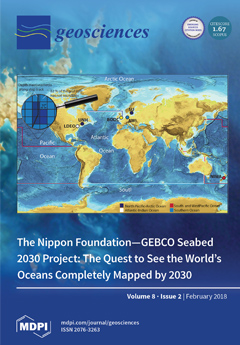With a wide spectrum of imaging capabilities—from optical to radar sensors, low to very high resolution, continental to local scale, single-image to multi-temporal approaches, yearly to sub-daily acquisition repeat cycles—Earth Observation (EO) offers several opportunities for the geoscience community to map and monitor
[...] Read more.
With a wide spectrum of imaging capabilities—from optical to radar sensors, low to very high resolution, continental to local scale, single-image to multi-temporal approaches, yearly to sub-daily acquisition repeat cycles—Earth Observation (EO) offers several opportunities for the geoscience community to map and monitor natural and human-induced Earth hazards from space. The Special Issue “Observing Geohazards from Space” of
Geosciences gathers 12 research articles on the development, validation, and implementation of satellite EO data, processing methods, and applications for mapping and monitoring of geohazards such as slow moving landslides, ground subsidence and uplift, and active and abandoned mining-induced ground movements. Papers published in this Special Issue provide novel case studies demonstrating how EO and remote sensing data can be used to detect and delineate land instability and geological hazards in different environmental contexts and using a range of spatial resolutions and image processing methods. Remote sensing datasets used in the Special Issue papers encompass satellite imagery from the ERS-1/2, ENVISAT, RADARSAT-1/2, and Sentinel-1 C-band, TerraSAR-X and COSMO-SkyMed X-band, and ALOS L-band SAR missions; Landsat 7, SPOT-5, WorldView-2/3, and Sentinel-2 multi-spectral data; UAV-derived RGB and near infrared aerial photographs; LiDAR surveying; and GNSS positioning data. Techniques that are showcased include, but are not limited to, differential Interferometric SAR (InSAR) and its advanced approaches such as Persistent Scatterers (PS) and Small Baseline Subset (SBAS) methods to estimate ground deformation, Object-Based Image Analysis (OBIA) to identify landslides in high resolution multi-spectral data, UAV and airborne photogrammetry, Structure-from-Motion (SfM) for digital elevation model generation, aerial photo-interpretation, feature extraction, and time series analysis. Case studies presented in the papers focus on landslides, natural and human-induced subsidence, and groundwater management and mining-related ground deformation in many local to regional-scale study areas in Austria, Belgium, Italy, Slovakia, Spain, and the UK.
Full article





